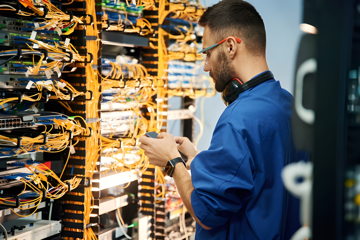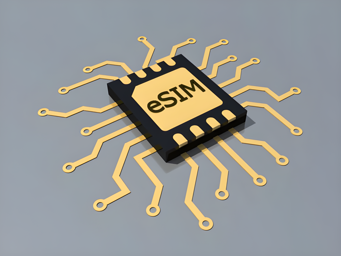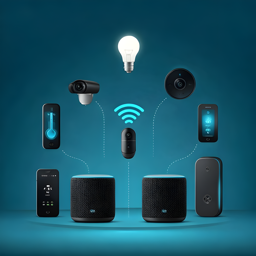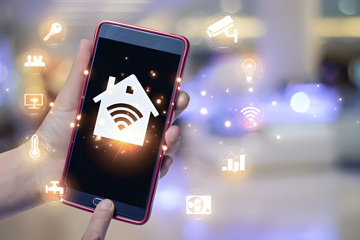Optimizing NB-IoT Antenna Design for ESP32 Deployments
Building IoT Solutions: Mastering TCO with ESP32 Tech
Building IoT solutions Connecting ESP32 to Cloud Services via Wi-FiDiscover how to connect your ESP32 to AWS, Azure, and Google Cloud using secure Wi-Fi. This guide covers setup, error handling, and low power strategies. with the ESP32? While the microcontroller
Connecting ESP32 to Cloud Services via Wi-FiDiscover how to connect your ESP32 to AWS, Azure, and Google Cloud using secure Wi-Fi. This guide covers setup, error handling, and low power strategies. with the ESP32? While the microcontroller Connecting ESP32 to Cloud Services via Wi-FiDiscover how to connect your ESP32 to AWS, Azure, and Google Cloud using secure Wi-Fi. This guide covers setup, error handling, and low power strategies. itself is affordable, the real cost
Connecting ESP32 to Cloud Services via Wi-FiDiscover how to connect your ESP32 to AWS, Azure, and Google Cloud using secure Wi-Fi. This guide covers setup, error handling, and low power strategies. itself is affordable, the real cost Quick Comparison: Range, power consumption, costs, and complexity of each technologyDiscover the ideal wireless solution for your ESP32 IoT project by analyzing range, power, cost, and complexity. Optimize connectivity now. lies in connectivity choices. From LoRa’s frugality to LTE’s bandwidth
Quick Comparison: Range, power consumption, costs, and complexity of each technologyDiscover the ideal wireless solution for your ESP32 IoT project by analyzing range, power, cost, and complexity. Optimize connectivity now. lies in connectivity choices. From LoRa’s frugality to LTE’s bandwidth Adaptive Data Rate (ADR) Optimization for LoRaWAN on ESP32Optimize your IoT network with our ADR tutorial for ESP32 in LoRaWAN. Learn dynamic transmission tuning, power management, and troubleshooting strategies., every protocol impacts your budget in hidden ways. This guide dissects hardware, data, maintenance, and scalability costs to help you optimize TCO.
Adaptive Data Rate (ADR) Optimization for LoRaWAN on ESP32Optimize your IoT network with our ADR tutorial for ESP32 in LoRaWAN. Learn dynamic transmission tuning, power management, and troubleshooting strategies., every protocol impacts your budget in hidden ways. This guide dissects hardware, data, maintenance, and scalability costs to help you optimize TCO.
Table of Contents🔗
- Understanding Total Cost
 Quick Comparison: Range, power consumption, costs, and complexity of each technologyDiscover the ideal wireless solution for your ESP32 IoT project by analyzing range, power, cost, and complexity. Optimize connectivity now. of Ownership
Quick Comparison: Range, power consumption, costs, and complexity of each technologyDiscover the ideal wireless solution for your ESP32 IoT project by analyzing range, power, cost, and complexity. Optimize connectivity now. of Ownership - Hardware Costs
 Quick Comparison: Range, power consumption, costs, and complexity of each technologyDiscover the ideal wireless solution for your ESP32 IoT project by analyzing range, power, cost, and complexity. Optimize connectivity now.: Modules, Antennas, and Peripherals
Quick Comparison: Range, power consumption, costs, and complexity of each technologyDiscover the ideal wireless solution for your ESP32 IoT project by analyzing range, power, cost, and complexity. Optimize connectivity now.: Modules, Antennas, and Peripherals - Connectivity and Data Plan Expenses
 Quick Comparison: Range, power consumption, costs, and complexity of each technologyDiscover the ideal wireless solution for your ESP32 IoT project by analyzing range, power, cost, and complexity. Optimize connectivity now.
Quick Comparison: Range, power consumption, costs, and complexity of each technologyDiscover the ideal wireless solution for your ESP32 IoT project by analyzing range, power, cost, and complexity. Optimize connectivity now. - Development and Maintenance Complexity
 Quick Comparison: Range, power consumption, costs, and complexity of each technologyDiscover the ideal wireless solution for your ESP32 IoT project by analyzing range, power, cost, and complexity. Optimize connectivity now.
Quick Comparison: Range, power consumption, costs, and complexity of each technologyDiscover the ideal wireless solution for your ESP32 IoT project by analyzing range, power, cost, and complexity. Optimize connectivity now. - Power Consumption
 Quick Comparison: Range, power consumption, costs, and complexity of each technologyDiscover the ideal wireless solution for your ESP32 IoT project by analyzing range, power, cost, and complexity. Optimize connectivity now. and Battery Life
Quick Comparison: Range, power consumption, costs, and complexity of each technologyDiscover the ideal wireless solution for your ESP32 IoT project by analyzing range, power, cost, and complexity. Optimize connectivity now. and Battery Life - Scalability and Future-Proofing
- Case Studies
 Zigbee Green Power: Ultra-Low-Power Energy Harvesting SolutionsDiscover how ZGP enables battery-free IoT devices through energy harvesting with ESP32 integrations, supporting smart home and industrial applications.: Smart Agriculture Networks
Zigbee Green Power: Ultra-Low-Power Energy Harvesting SolutionsDiscover how ZGP enables battery-free IoT devices through energy harvesting with ESP32 integrations, supporting smart home and industrial applications.: Smart Agriculture Networks - Decision Matrix: Choosing Cost
 Quick Comparison: Range, power consumption, costs, and complexity of each technologyDiscover the ideal wireless solution for your ESP32 IoT project by analyzing range, power, cost, and complexity. Optimize connectivity now.-Effective Connectivity
Quick Comparison: Range, power consumption, costs, and complexity of each technologyDiscover the ideal wireless solution for your ESP32 IoT project by analyzing range, power, cost, and complexity. Optimize connectivity now.-Effective Connectivity - Strategies to Optimize TCO
Understanding Total Cost of Ownership🔗
Total Cost of Ownership (TCO) is the sum of all expenses Quick Comparison: Range, power consumption, costs, and complexity of each technologyDiscover the ideal wireless solution for your ESP32 IoT project by analyzing range, power, cost, and complexity. Optimize connectivity now. over your project’s lifecycle:
Quick Comparison: Range, power consumption, costs, and complexity of each technologyDiscover the ideal wireless solution for your ESP32 IoT project by analyzing range, power, cost, and complexity. Optimize connectivity now. over your project’s lifecycle:
- Upfront Costs
 Quick Comparison: Range, power consumption, costs, and complexity of each technologyDiscover the ideal wireless solution for your ESP32 IoT project by analyzing range, power, cost, and complexity. Optimize connectivity now.: Hardware, certifications, development.
Quick Comparison: Range, power consumption, costs, and complexity of each technologyDiscover the ideal wireless solution for your ESP32 IoT project by analyzing range, power, cost, and complexity. Optimize connectivity now.: Hardware, certifications, development. - Operational Costs
 Quick Comparison: Range, power consumption, costs, and complexity of each technologyDiscover the ideal wireless solution for your ESP32 IoT project by analyzing range, power, cost, and complexity. Optimize connectivity now.: Data plans, power, maintenance.
Quick Comparison: Range, power consumption, costs, and complexity of each technologyDiscover the ideal wireless solution for your ESP32 IoT project by analyzing range, power, cost, and complexity. Optimize connectivity now.: Data plans, power, maintenance. - Future Costs
 Quick Comparison: Range, power consumption, costs, and complexity of each technologyDiscover the ideal wireless solution for your ESP32 IoT project by analyzing range, power, cost, and complexity. Optimize connectivity now.: Scalability, upgrades, retrofits.
Quick Comparison: Range, power consumption, costs, and complexity of each technologyDiscover the ideal wireless solution for your ESP32 IoT project by analyzing range, power, cost, and complexity. Optimize connectivity now.: Scalability, upgrades, retrofits. - Example: Choosing LTE-M
 Delta Updates: Reducing OTA Payload Size for Cellular NetworksLearn how delta updates reduce data usage, improve speed, and cut costs for ESP32 firmware patches over NB-IoT/LTE-M cellular networks. over LoRa might save development time but increase 5-year TCO by 4x due to data fees and power demands.
Delta Updates: Reducing OTA Payload Size for Cellular NetworksLearn how delta updates reduce data usage, improve speed, and cut costs for ESP32 firmware patches over NB-IoT/LTE-M cellular networks. over LoRa might save development time but increase 5-year TCO by 4x due to data fees and power demands.
Hardware Costs: Modules, Antennas, and Peripherals🔗
The ESP32’s Combining Wi-Fi with Deep Sleep for Low-Power ApplicationsLearn how to integrate Wi-Fi and deep sleep on ESP32 to maximize battery life in IoT devices. This guide offers practical tips and step-by-step instructions. built-in Wi-Fi/BLE is free, but external protocols add costs
Combining Wi-Fi with Deep Sleep for Low-Power ApplicationsLearn how to integrate Wi-Fi and deep sleep on ESP32 to maximize battery life in IoT devices. This guide offers practical tips and step-by-step instructions. built-in Wi-Fi/BLE is free, but external protocols add costs Quick Comparison: Range, power consumption, costs, and complexity of each technologyDiscover the ideal wireless solution for your ESP32 IoT project by analyzing range, power, cost, and complexity. Optimize connectivity now.:
Quick Comparison: Range, power consumption, costs, and complexity of each technologyDiscover the ideal wireless solution for your ESP32 IoT project by analyzing range, power, cost, and complexity. Optimize connectivity now.:
| Protocol | Module | Unit Cost | Antenna Cost | Peripherals |
|---|---|---|---|---|
| Wi-Fi | Native | $0 | $0 | None |
| BLE | Native | $0 | $0 | None |
| LoRa | SX1276 | $4-$8 | $2 (PCB) | SPI Interface, GPIOs |
| Sigfox | Wisol SFM10R1 | $12-$18 | $5 (Ceramic) | UART, Power Regulator |
| NB-IoT | Quectel BC66 | $20-$25 | $10 (Dipole) | SIM Card, 12V Power Supply |
| LTE-M | SIM7000G | $35-$45 | $15 (Active) | GNSS Antenna, Heat Sink |
| Zigbee | CC2652P | $15-$30 | $3 (PCB) | Mesh Network Stack |
Example Calculation:
# Cost for 100-node LoRa vs. LTE-M network
lora_total = 100 * (8 + 2) + 500 # Modules, antennas, 1 gateway
lte_total = 100 * (45 + 15) + 2000 # Modules, antennas, data plans
print(f"LoRa: ${lora_total}, LTE-M: ${lte_total}")
# Output: LoRa: $1500, LTE-M: $8000
Connectivity and Data Plan Expenses🔗
| Protocol | Data Plan Cost | Payload Limits | Key Considerations |
|---|---|---|---|
| LoRa | $0.50-$3/node/month | 51-222 bytes/packet | Free on TTN; private gateways add cost |
| Sigfox | €1.20-$7/node/month | 12 bytes/uplink | Regional pricing, 140 messages/day |
| NB-IoT | $0.10-$0.50/MB | 1KB-10KB/session | AWS IoT SIM: $0.03/device/month |
| LTE-M | $5-$20/node/month | 1MB+/day | Higher bandwidth, 5G-compatible |
| Wi-Fi | $0 (local) | Unlimited (local) | Cloud integration fees apply |
Power vs. Data Tradeoff:
A sensor sending 12 bytes/hour:
- LoRa
 ESP32 Multi-Protocol Gateways: Combining Wi-Fi, BLE, and LoRaDiscover how to build a multi-protocol ESP32 gateway integrating Wi-Fi, BLE, and LoRa for scalable IoT deployments in smart cities and industry.: 8.64 KB/month → $0.10
ESP32 Multi-Protocol Gateways: Combining Wi-Fi, BLE, and LoRaDiscover how to build a multi-protocol ESP32 gateway integrating Wi-Fi, BLE, and LoRa for scalable IoT deployments in smart cities and industry.: 8.64 KB/month → $0.10 - LTE-M
 Delta Updates: Reducing OTA Payload Size for Cellular NetworksLearn how delta updates reduce data usage, improve speed, and cut costs for ESP32 firmware patches over NB-IoT/LTE-M cellular networks.: Same data → $0.03 (but + $5/month base fee)
Delta Updates: Reducing OTA Payload Size for Cellular NetworksLearn how delta updates reduce data usage, improve speed, and cut costs for ESP32 firmware patches over NB-IoT/LTE-M cellular networks.: Same data → $0.03 (but + $5/month base fee)
Development and Maintenance Complexity🔗
- Certification: FCC/CE compliance costs
 Quick Comparison: Range, power consumption, costs, and complexity of each technologyDiscover the ideal wireless solution for your ESP32 IoT project by analyzing range, power, cost, and complexity. Optimize connectivity now. $3,000-$10,000 per protocol.
Quick Comparison: Range, power consumption, costs, and complexity of each technologyDiscover the ideal wireless solution for your ESP32 IoT project by analyzing range, power, cost, and complexity. Optimize connectivity now. $3,000-$10,000 per protocol. - Time-to-Market:
- LoRa
 ESP32 Multi-Protocol Gateways: Combining Wi-Fi, BLE, and LoRaDiscover how to build a multi-protocol ESP32 gateway integrating Wi-Fi, BLE, and LoRa for scalable IoT deployments in smart cities and industry.: 2-3 weeks (TTN integration, custom encoding).
ESP32 Multi-Protocol Gateways: Combining Wi-Fi, BLE, and LoRaDiscover how to build a multi-protocol ESP32 gateway integrating Wi-Fi, BLE, and LoRa for scalable IoT deployments in smart cities and industry.: 2-3 weeks (TTN integration, custom encoding). - LTE-M: 1-2 weeks (AT command
 SIM7000G Module with ESP32: Configuring LTE-M and GNSSMaster ESP32 integration with SIM7000G for reliable LTE-M connectivity and precise GPS tracking, featuring hardware setup, AT commands, and power tips. setup).
SIM7000G Module with ESP32: Configuring LTE-M and GNSSMaster ESP32 integration with SIM7000G for reliable LTE-M connectivity and precise GPS tracking, featuring hardware setup, AT commands, and power tips. setup).
- LoRa
- OTA Updates
 Implementing Over-the-Air (OTA) Updates via Wi-Fi on ESP32Learn how to implement secure and reliable OTA updates on ESP32 for enhanced IoT performance, easy updates, and rollback capability without physical access.:
Implementing Over-the-Air (OTA) Updates via Wi-Fi on ESP32Learn how to implement secure and reliable OTA updates on ESP32 for enhanced IoT performance, easy updates, and rollback capability without physical access.:
- AWS IoT Jobs
 AWS IoT Core with ESP32: X.509 Certificates and Shadow UpdatesLearn to securely connect ESP32 to AWS IoT Core using X.509 certificates and device shadows, with step-by-step instructions and best practices.: $0.30/device/month.
AWS IoT Core with ESP32: X.509 Certificates and Shadow UpdatesLearn to securely connect ESP32 to AWS IoT Core using X.509 certificates and device shadows, with step-by-step instructions and best practices.: $0.30/device/month. - Wi-Fi
 Arquitetura ESP32: SoC dual-core, subsistemas RF integradosDiscover the ESP32’s dual-core prowess and integrated RF subsystems for efficient, innovative IoT applications—from smart homes to industrial sensors. OTA: Free (but requires stable network).
Arquitetura ESP32: SoC dual-core, subsistemas RF integradosDiscover the ESP32’s dual-core prowess and integrated RF subsystems for efficient, innovative IoT applications—from smart homes to industrial sensors. OTA: Free (but requires stable network).
- AWS IoT Jobs
Power Consumption and Battery Life🔗
10-Year Battery? Only With LoRa/Sigfox Sigfox Message Encoding: Packing Sensor Data into 12-byte PayloadsLearn efficient data encoding techniques for Sigfox's constrained 12-byte payloads. Discover bitwise operations, structured encoding & CBOR strategies.:
Sigfox Message Encoding: Packing Sensor Data into 12-byte PayloadsLearn efficient data encoding techniques for Sigfox's constrained 12-byte payloads. Discover bitwise operations, structured encoding & CBOR strategies.:
// Sleep currents (µA)
const float lora_sleep = 1.8;
const float lte_sleep = 5.5; // PSM mode
- LoRa
 ESP32 Multi-Protocol Gateways: Combining Wi-Fi, BLE, and LoRaDiscover how to build a multi-protocol ESP32 gateway integrating Wi-Fi, BLE, and LoRa for scalable IoT deployments in smart cities and industry.: 2xAA batteries → 142 months (theoretical).
ESP32 Multi-Protocol Gateways: Combining Wi-Fi, BLE, and LoRaDiscover how to build a multi-protocol ESP32 gateway integrating Wi-Fi, BLE, and LoRa for scalable IoT deployments in smart cities and industry.: 2xAA batteries → 142 months (theoretical). - LTE-M
 Delta Updates: Reducing OTA Payload Size for Cellular NetworksLearn how delta updates reduce data usage, improve speed, and cut costs for ESP32 firmware patches over NB-IoT/LTE-M cellular networks.: Same batteries → 58 months.
Delta Updates: Reducing OTA Payload Size for Cellular NetworksLearn how delta updates reduce data usage, improve speed, and cut costs for ESP32 firmware patches over NB-IoT/LTE-M cellular networks.: Same batteries → 58 months. - Sigfox
 Sigfox Message Encoding: Packing Sensor Data into 12-byte PayloadsLearn efficient data encoding techniques for Sigfox's constrained 12-byte payloads. Discover bitwise operations, structured encoding & CBOR strategies.: 10+ years (ultra-low duty cycle).
Sigfox Message Encoding: Packing Sensor Data into 12-byte PayloadsLearn efficient data encoding techniques for Sigfox's constrained 12-byte payloads. Discover bitwise operations, structured encoding & CBOR strategies.: 10+ years (ultra-low duty cycle). - Real-World Tip: LTE’s network join energy (120mA for 15s) drains batteries faster than LoRa
 ESP32 Multi-Protocol Gateways: Combining Wi-Fi, BLE, and LoRaDiscover how to build a multi-protocol ESP32 gateway integrating Wi-Fi, BLE, and LoRa for scalable IoT deployments in smart cities and industry.’s 30mA for 3s.
ESP32 Multi-Protocol Gateways: Combining Wi-Fi, BLE, and LoRaDiscover how to build a multi-protocol ESP32 gateway integrating Wi-Fi, BLE, and LoRa for scalable IoT deployments in smart cities and industry.’s 30mA for 3s.
Scalability and Future-Proofing🔗
- LoRa
 ESP32 Multi-Protocol Gateways: Combining Wi-Fi, BLE, and LoRaDiscover how to build a multi-protocol ESP32 gateway integrating Wi-Fi, BLE, and LoRa for scalable IoT deployments in smart cities and industry.: 1 gateway
ESP32 Multi-Protocol Gateways: Combining Wi-Fi, BLE, and LoRaDiscover how to build a multi-protocol ESP32 gateway integrating Wi-Fi, BLE, and LoRa for scalable IoT deployments in smart cities and industry.: 1 gateway ESP32 Multi-Protocol Gateways: Combining Wi-Fi, BLE, and LoRaDiscover how to build a multi-protocol ESP32 gateway integrating Wi-Fi, BLE, and LoRa for scalable IoT deployments in smart cities and industry. ($300) covers 1,000 nodes. Scalable for rural/low-data use.
ESP32 Multi-Protocol Gateways: Combining Wi-Fi, BLE, and LoRaDiscover how to build a multi-protocol ESP32 gateway integrating Wi-Fi, BLE, and LoRa for scalable IoT deployments in smart cities and industry. ($300) covers 1,000 nodes. Scalable for rural/low-data use. - LTE-M
 Delta Updates: Reducing OTA Payload Size for Cellular NetworksLearn how delta updates reduce data usage, improve speed, and cut costs for ESP32 firmware patches over NB-IoT/LTE-M cellular networks.: Per-SIM costs
Delta Updates: Reducing OTA Payload Size for Cellular NetworksLearn how delta updates reduce data usage, improve speed, and cut costs for ESP32 firmware patches over NB-IoT/LTE-M cellular networks.: Per-SIM costs Quick Comparison: Range, power consumption, costs, and complexity of each technologyDiscover the ideal wireless solution for your ESP32 IoT project by analyzing range, power, cost, and complexity. Optimize connectivity now. but mobile-friendly.
Quick Comparison: Range, power consumption, costs, and complexity of each technologyDiscover the ideal wireless solution for your ESP32 IoT project by analyzing range, power, cost, and complexity. Optimize connectivity now. but mobile-friendly. - Zigbee
 Interfacing ESP32 with Zigbee3.0 Devices (Xiaomi, Philips Hue)Unlock seamless smart home integration by following our detailed guide on bridging ESP32 with external Zigbee modules for reliable IoT solutions.: Best for dense networks (smart homes).
Interfacing ESP32 with Zigbee3.0 Devices (Xiaomi, Philips Hue)Unlock seamless smart home integration by following our detailed guide on bridging ESP32 with external Zigbee modules for reliable IoT solutions.: Best for dense networks (smart homes). - Lock-In Risks: Sigfox
 Sigfox Message Encoding: Packing Sensor Data into 12-byte PayloadsLearn efficient data encoding techniques for Sigfox's constrained 12-byte payloads. Discover bitwise operations, structured encoding & CBOR strategies. (proprietary) vs. LoRa (open standard).
Sigfox Message Encoding: Packing Sensor Data into 12-byte PayloadsLearn efficient data encoding techniques for Sigfox's constrained 12-byte payloads. Discover bitwise operations, structured encoding & CBOR strategies. (proprietary) vs. LoRa (open standard).
Case Studies: Smart Agriculture Networks🔗
Soil Monitoring (5-Year TCO)
| Cost Factor | LoRa + ESP32 | LTE-M + ESP32 |
|---|---|---|
| Hardware | $6,500 | $27,500 |
| Yearly Data | $900 (TTN) | $4,200 (AWS IoT) |
| Maintenance | $200/node-year | $75/node-year |
| Total TCO | $17,000 | $62,750 |
Urban Smart Parking (100 Nodes)
| Protocol | Hardware Cost | 5-Year Data Cost |
|---|---|---|
| NB-IoT | $4,000 | $6,000 |
| Sigfox | $3,500 | $4,200 |
Decision Matrix: Choosing Cost-Effective Connectivity🔗
| Protocol | Best For | Avoid If |
|---|---|---|
| BLE | Short-range, high update rate | Network > 10 devices, no gateway |
| LoRa | Sparse data, rural areas | Real-time control, payload > 100B |
| LTE-M | Mobile assets, video streaming | Battery life > 3 years, low budget |
| Sigfox | Global, low-power deployments | High data volume, frequent updates |
Strategies to Optimize TCO🔗
1. Leverage Native Connectivity: Use ESP32’s Combining Wi-Fi with Deep Sleep for Low-Power ApplicationsLearn how to integrate Wi-Fi and deep sleep on ESP32 to maximize battery life in IoT devices. This guide offers practical tips and step-by-step instructions. Wi-Fi/BLE before adding radios.
Combining Wi-Fi with Deep Sleep for Low-Power ApplicationsLearn how to integrate Wi-Fi and deep sleep on ESP32 to maximize battery life in IoT devices. This guide offers practical tips and step-by-step instructions. Wi-Fi/BLE before adding radios.
2. Bulk Purchasing: Negotiate 30-50% discounts for module orders >1,000 units.
3. Hybrid Networks: Combine LoRa (sensors) + LTE (gateways ESP32 Multi-Protocol Gateways: Combining Wi-Fi, BLE, and LoRaDiscover how to build a multi-protocol ESP32 gateway integrating Wi-Fi, BLE, and LoRa for scalable IoT deployments in smart cities and industry.).
ESP32 Multi-Protocol Gateways: Combining Wi-Fi, BLE, and LoRaDiscover how to build a multi-protocol ESP32 gateway integrating Wi-Fi, BLE, and LoRa for scalable IoT deployments in smart cities and industry.).
- Sync deep sleep
 LTE Power Saving: Combining PSM and DRX with ESP32 Sleep ModesDiscover how combining LTE power-saving modes with ESP32 sleep techniques can extend battery life in IoT devices while ensuring reliable connectivity. with transmission intervals.
LTE Power Saving: Combining PSM and DRX with ESP32 Sleep ModesDiscover how combining LTE power-saving modes with ESP32 sleep techniques can extend battery life in IoT devices while ensuring reliable connectivity. with transmission intervals. - Use edge computing to reduce data payloads.
5. Pre-Certified Modules: Reduce compliance costs Quick Comparison: Range, power consumption, costs, and complexity of each technologyDiscover the ideal wireless solution for your ESP32 IoT project by analyzing range, power, cost, and complexity. Optimize connectivity now. by 60%.
Quick Comparison: Range, power consumption, costs, and complexity of each technologyDiscover the ideal wireless solution for your ESP32 IoT project by analyzing range, power, cost, and complexity. Optimize connectivity now. by 60%.
Final Takeaway: Your cheapest option isn’t on this sheet-it’s using the ESP32’s Combining Wi-Fi with Deep Sleep for Low-Power ApplicationsLearn how to integrate Wi-Fi and deep sleep on ESP32 to maximize battery life in IoT devices. This guide offers practical tips and step-by-step instructions. native Wi-Fi/BLE. Before adding radios, ask: "Can I solve this with what’s already onboard?"
Combining Wi-Fi with Deep Sleep for Low-Power ApplicationsLearn how to integrate Wi-Fi and deep sleep on ESP32 to maximize battery life in IoT devices. This guide offers practical tips and step-by-step instructions. native Wi-Fi/BLE. Before adding radios, ask: "Can I solve this with what’s already onboard?"
Author: Marcelo V. Souza - Engenheiro de Sistemas e Entusiasta em IoT e Desenvolvimento de Software, com foco em inovação tecnológica.
References🔗
- Arduino Forum: forum.arduino.cc
- Arduino IDE Official Website: arduino.cc
- ESP-IDF Programming Guide: docs.espressif.com/projects/esp-idf
- ESP32 Arduino Core Documentation: docs.espressif.com/projects/arduino-esp32
- Espressif Documentation: docs.espressif.com
 9 months ago
9 months ago
 9 months ago
9 months ago
 9 months ago
9 months ago
 9 months ago
9 months ago
 9 months ago
9 months ago
 9 months ago
9 months ago
 9 months ago
9 months ago
 10 months ago
10 months ago
 9 months ago
9 months ago
 10 months ago
10 months ago
 9 months ago
9 months ago
 9 months ago
9 months ago
 9 months ago
9 months ago
 9 months ago
9 months ago
 9 months ago
9 months ago
 9 months ago
9 months ago
 9 months ago
9 months ago
 9 months ago
9 months ago
 9 months ago
9 months ago
 9 months ago
9 months ago
 9 months ago
9 months ago
 9 months ago
9 months ago